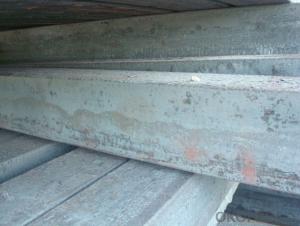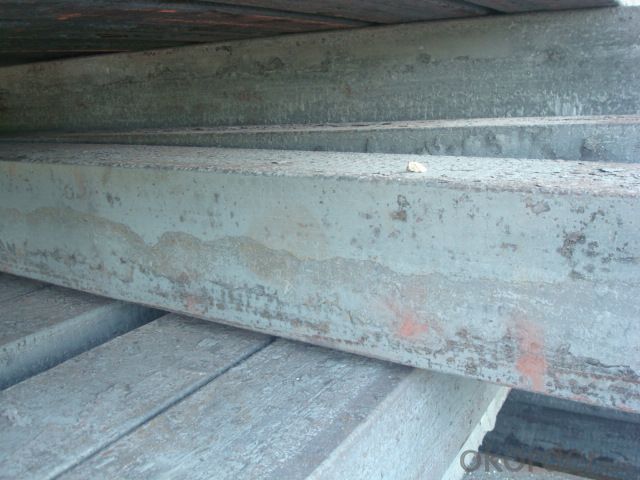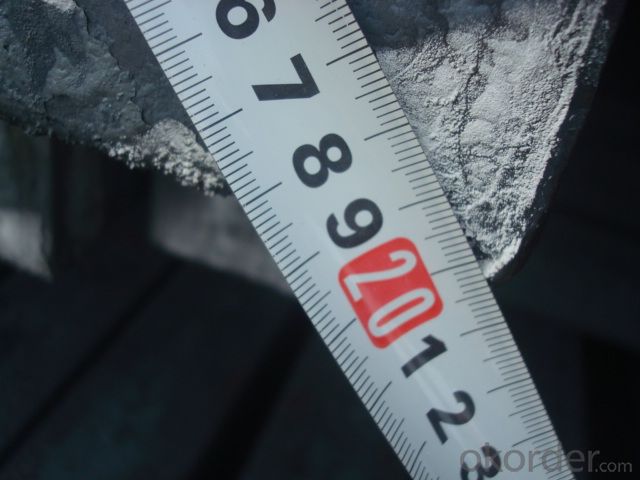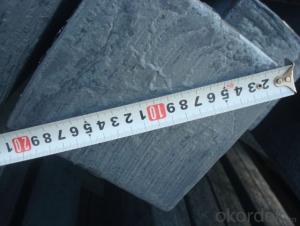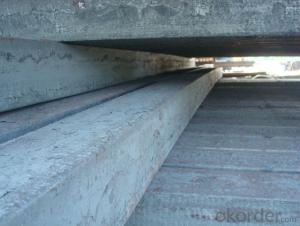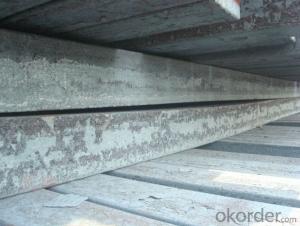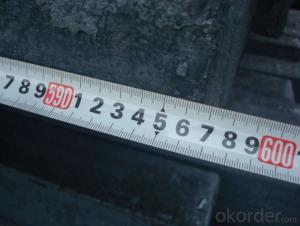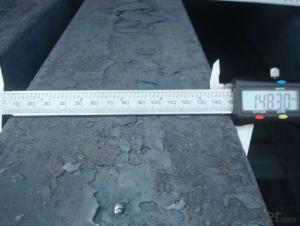Continue Casting Steel Bloom Made by Blast Furnace
- Loading Port:
- Tianjin
- Payment Terms:
- TT OR LC
- Min Order Qty:
- 1000 m.t.
- Supply Capability:
- 100000 m.t./month
OKorder Service Pledge
OKorder Financial Service
You Might Also Like
Continue Casting Steel Bloom Made by Blast Furnace
1.Structure of Continue Casting Steel Bloom Made by Blast Furnace
Continue Casting Steel Bloom Made by Blast Furnaceis the raw material of all kinds of steel products.For example, Billet section of square, round, flat, rectangular and abnormity, etc Several, mainly related to shape of rolled products. Simple rolled section steel, choose cross section of square billet or rectangular billet. rolling The sector products such as flat steel, Angle steel, select the rectangular billet or slab. There are diffirents kinds of the spec. for the steel billet, in the past, Many steel mill produce the steel billet by Electrice furnace, but now most of the steel billet manufactured by blast furnace.
2.Main Features of Continue Casting Steel Bloom Made by Blast Furnace
Continue Casting Steel Bloom by Blast Furnace section size is normally includes 120*120,130*130,150*150,160*160,165*165 and so on. And also includes the retangular size, it depands on the usage of the steel billet. simplify the stock management of workshop.
3. Continue Casting Steel Bloom Made by Blast Furnace Images
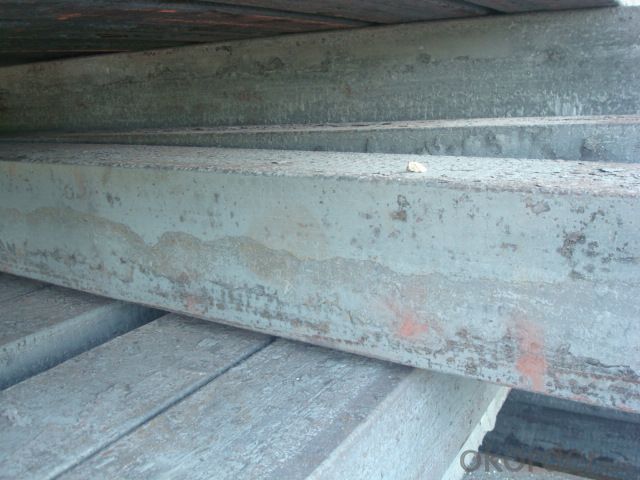
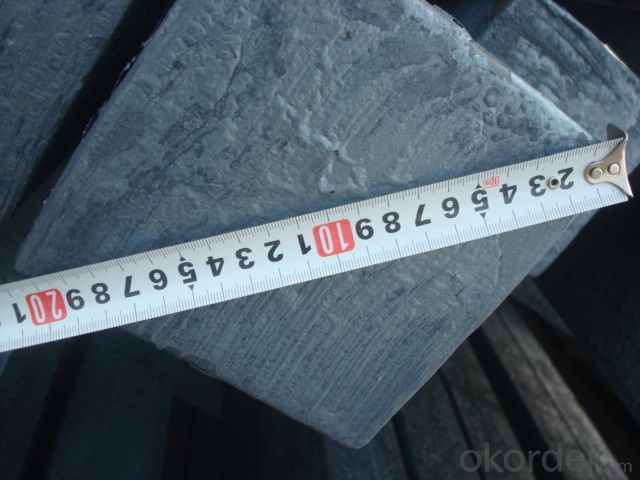
4. Continue Casting Steel Bloom Made by Blast Furnace Specification
Continue Casting Steel Bloom by Blast Furnace rolled steel, after processing can be used for mechanical parts, forging parts, processing all kinds of steel, steel Q345B channel steel, wire rod is the role of the billet. Steel billet is used in the production of semi-finished products, generally cannot be used directly for the society. Steel billets and steel are strictly divided into standard, cannot decide to whether the business enterprise of the final product, and according to unified standards to perform the whole society. Typically, billet and the steel is relatively easy to distinguish, but for some steel billet, and have the same specification and same steel purposes (such as rolling tube billet), whether can be used for other industries, whether through steel processing process, whether through a finished product rolling mill processing to distinguish
Material standard The editor Range of thickness: 150-240 - mm + / - 5 mm width range: 880-1530 - mm + / - 20 mm Length: 3700-10000 - mm + / - 500 - mm Cross-sectional size: 64 * 64; 82 * 82; 98 * 98; 124 * 124; 120 * 150; 152 * 164; 152 * 170 mm Length: 9000 mm Section of tolerance: billet: 1.0 + / - 2.0-1.0 + / - 1.0 mm slab: width: + / - 2.0 mm thickness: + / - 3.0 mm The length tolerance: + / - 200 mm Section diagonal tolerance: 3.5-8.0 MM Billet section size protrusions requirements: < 1242 mm, do not allow; > = 1242 mm, < = 2 mm 1242 mm, < = 3 mm Beheading (shear) extension deformation: < 1242 mm billet: no control; The slab: < = 15 mm Surface tilt: no more than billet section 0.1 Bending: every 1 m length is not more than 10 mm The distortion: length < = 5 m, < = 11. ; The length of the < = 7.5 M, < = 5. Material % 3 sp/PS chemical composition: C Mn Si S P
Mainly from the shape is divided into two kinds:Slab: cross section width and height of the ratio of the larger, mainly used for rolling plate.Billet: equal cross section width and height, or a huge difference, mainly used for rolling steel, wire rod.Material part of the standard:Range of thickness: 150-240 - mm + / - 5 mmThe width of the range: 880-1530 - mm + / - 20 mmLength: 3700-10000 - mm + / - 500 - mmCross-sectional size: 64 * 64;82 * 82;98 * 98;124 * 124;120 * 150;152 * 164;152 * 170 mm
5.FAQ of Continue Casting Steel Bloom Made by Blast Furnace
We have organized several common questions for our clients,may help you sincerely:
①Could we get the SGS Certificate with other documents together?
Yes you can if you pay the SGS inspecting fee in advanced, we will arrange that inspection for you before loading and will get the certificate then.
②If some quality problem happen, how long we can get the settlement?
about 7-30 days, depands on the situation of the cargo, if you report it earlier, it will be easier to check and get the result of inspecting, or you can apply the SGS inspecting.
③How many tons is the Minimum order quantity?
The Minimum order quantity is 1000tons, if your spec. is normal size, otherwise, need to comfirm with our steel mill for the detail order.
- Q: How are steel billets classified based on their chemical composition?
- Different grading systems can be used to classify steel billets based on their chemical composition. One commonly used method involves categorizing the billets into three main groups: low carbon steel billets, medium carbon steel billets, and high carbon steel billets. Low carbon steel billets typically contain less than 0.25% carbon and are known for their excellent ductility and weldability. They are often used in applications that require good formability and low strength, such as construction materials and automotive components. Medium carbon steel billets, on the other hand, have a carbon content ranging from 0.25% to 0.60%. These billets offer improved strength and hardness compared to low carbon steel billets and are commonly used in applications that require higher strength, such as machinery parts, shafts, and gears. High carbon steel billets have a carbon content greater than 0.60% and are recognized for their exceptional strength and hardness. They are commonly used in applications that demand high wear resistance, such as cutting tools, springs, and knives. In addition to carbon content, the presence of other chemical elements in the steel billets can also impact their classification. Elements like chromium, nickel, and molybdenum, known as alloying elements, can enhance the properties of the steel, such as corrosion resistance or heat resistance. Steel billets can therefore be further classified based on the specific alloying elements present and their concentrations. Overall, classifying steel billets based on their chemical composition allows for a better understanding and selection of the appropriate material for specific applications. This ensures that the desired properties and performance of the final product are achieved.
- Q: How do steel billets contribute to the environmental sector?
- There are several ways in which steel billets contribute to the environmental sector. Firstly, the production of steel billets often involves the recycling of scrap metal, which helps decrease the demand for raw materials and conserve natural resources. This process also reduces the energy needed for steel production, resulting in lower greenhouse gas emissions and a smaller carbon footprint. Moreover, steel billets find extensive use in construction projects, including the development of infrastructure and renewable energy installations. Steel is an incredibly durable material that can withstand harsh weather conditions and has a long lifespan. By utilizing steel billets in construction, we can create structures that require minimal maintenance and repair, reducing the necessity for frequent replacements and conserving additional resources. Furthermore, steel billets play a crucial role in the manufacturing of environmentally friendly products. Steel is a crucial component in the production of electric vehicles, wind turbines, and solar panels. These clean energy solutions aid in reducing our dependence on fossil fuels and decreasing harmful emissions, thus contributing to a cleaner and greener environment. Additionally, steel billets can be recycled once again at the end of their lifespan, further diminishing waste and minimizing the environmental impact. Recycling steel is an extremely efficient process that necessitates less energy and generates fewer emissions compared to the production of new steel from raw materials. In conclusion, steel billets contribute to the environmental sector through their recycling capabilities, durability in construction, and their role in the manufacturing of eco-friendly products. By incorporating steel billets into various industries, we can promote sustainability, conserve resources, and diminish our environmental footprint.
- Q: How do steel billets contribute to the manufacturing of consumer goods?
- Steel billets play a crucial role in the manufacturing of consumer goods by serving as the raw material for a wide range of products. These billets are essentially semi-finished steel products that are created through the casting process. They are solid blocks of steel that are heated and then shaped into a specific form, which can vary depending on the intended application. One of the primary ways steel billets contribute to the manufacturing of consumer goods is through their use in the production of various metal parts. These parts can be found in a multitude of products, such as automobiles, appliances, machinery, and furniture. By using steel billets as the starting material, manufacturers can create components that are strong, durable, and resistant to wear and tear. This ensures that the final consumer goods have a long lifespan and can withstand the demands of everyday use. Furthermore, steel billets are often used in the construction industry for the production of structural steel beams, columns, and other building materials. These components are crucial for the construction of infrastructure, residential buildings, commercial complexes, and other structures. Steel's high strength-to-weight ratio makes it an ideal material for these applications, providing the necessary structural support while minimizing the overall weight and cost. In addition to their strength and durability, steel billets also offer versatility in terms of their formability and machinability. This means that they can be easily shaped, welded, and cut into various sizes and designs, allowing manufacturers to tailor the steel components to meet specific consumer needs. This flexibility enables the production of a wide range of consumer goods, from small intricate parts to large complex structures. The use of steel billets in the manufacturing of consumer goods also contributes to sustainability. Steel is a highly recyclable material, and the production of steel products using recycled steel requires significantly less energy and resources compared to using virgin materials. This helps reduce the environmental impact associated with consumer goods production and promotes a more circular economy. Overall, steel billets are a crucial ingredient in the manufacturing of consumer goods. Their strength, durability, versatility, and recyclability make them an ideal material choice for producing a wide range of products that meet the needs and expectations of consumers.
- Q: Is there an export duty? Or is there a tax refund?
- It's too broad. What kind of material (contains all kinds of metal components in order to confirm HS coding)?
- Q: What is the lifespan of a steel billet?
- The lifespan of a steel billet can vary depending on several factors such as the quality of the steel, the conditions in which it is stored and used, and the specific application it is being used for. Generally, steel billets are designed to have a long lifespan and can be used for many years without significant degradation. Steel billets are typically made from high-quality steel that is specifically engineered to have excellent strength, durability, and resistance to corrosion. This ensures that the billet can withstand the rigors of various industrial processes and applications. In terms of storage and usage conditions, steel billets need to be stored in a dry and controlled environment to prevent moisture and other contaminants from causing rust or degradation. They should also be handled and transported carefully to prevent any physical damage that could compromise their integrity. The lifespan of a steel billet also depends on the specific application it is being used for. Some billets are used in high-stress applications such as construction, automotive manufacturing, or heavy machinery, where they may undergo significant wear and tear. In these cases, the lifespan of the billet can be shorter compared to less demanding applications. Overall, with proper care, maintenance, and adherence to recommended usage guidelines, a steel billet can have a long lifespan ranging from several years to decades. Regular inspections, maintenance, and replacement of worn or damaged billets are essential to ensure optimal performance and safety in various industries.
- Q: How are steel billets used in the production of pump parts?
- Steel billets are an essential component in the production of pump parts. These billets, which are semi-finished metal forms, serve as the starting material for manufacturing various pump components. Firstly, steel billets are heated and then molded into the required shape using a range of techniques such as forging, casting, or extrusion. This process ensures that the billets are transformed into the desired pump part, such as impellers, casings, or shafts. Once the billets have been shaped, they undergo further machining processes, such as milling, drilling, and turning, to achieve the precise dimensions and specifications needed for pump parts. These machining operations ensure that the billets are transformed into functional components that can effectively perform their intended tasks within the pump system. Moreover, steel billets provide the necessary strength and durability required for pump parts to withstand the demanding conditions and pressures associated with pumping operations. The high tensile strength and resistance to corrosion of steel make it an ideal material choice for pump components, ensuring their longevity and reliability. In addition, steel billets can be further treated or coated to enhance their performance characteristics. For instance, they can undergo heat treatment processes such as annealing, quenching, or tempering to achieve specific mechanical properties, such as improved hardness or increased resistance to wear and tear. Coatings, such as galvanizing or electroplating, can also be applied to steel billets to enhance their corrosion resistance. Overall, steel billets play a crucial role in the production of pump parts by providing a versatile and robust starting material that can be shaped, machined, and treated to meet the specific requirements of different pump systems. By utilizing steel billets, pump manufacturers can produce high-quality pump parts that ensure efficient and reliable pumping operations across various industries.
- Q: What is the role of steel billets in the manufacturing of automotive transmission systems?
- Steel billets play a crucial role in the manufacturing of automotive transmission systems as they are the starting material for forging various components such as gears, shafts, and other critical parts. The billets are heated and then shaped through the forging process to achieve the desired dimensions and strength required for these transmission components. The use of steel billets ensures the durability, reliability, and overall performance of automotive transmission systems in vehicles.
- Q: What are the potential applications of steel billets in the telecommunications industry?
- The telecommunications industry benefits greatly from the wide range of potential applications offered by steel billets. A key application lies in the construction of telecommunication towers, where steel billets serve as the foundation for manufacturing the structural components. These components provide the necessary strength and durability to support the weight of antennas and other equipment. Moreover, steel billets play a vital role in the production of transmission line hardware, including pole line fittings, brackets, and clamps. These components are crucial for ensuring the stability and reliability of telecommunication lines during installation and maintenance. Furthermore, steel billets are essential in the manufacturing of enclosures, both underground and overhead, that protect telecommunication cables from external factors such as moisture, heat, and physical damage. This protection guarantees uninterrupted communication. In addition, steel billets are utilized in the production of telecommunication equipment cabinets and racks, which provide a secure and organized space for housing network equipment, such as servers, switches, and routers. The strength and rigidity of steel billets make them ideal for supporting heavy equipment and protecting against environmental hazards. Lastly, steel billets find application in the construction of telecommunication infrastructure, including base stations and equipment shelters. These structures require robust materials to withstand harsh weather conditions and provide a stable foundation for the installation of telecommunications equipment. In conclusion, the versatility and durability of steel billets make them ideal for various aspects of the telecommunications industry, from tower construction to cable enclosures and equipment cabinets. Steel billets provide the necessary support and protection for telecommunication infrastructure and equipment.
- Q: What are the main factors affecting the hardenability of stainless steel billets?
- The main factors affecting the hardenability of stainless steel billets are the chemical composition of the steel, the cooling rate during heat treatment, and the presence of alloying elements such as chromium, nickel, and molybdenum. The chemical composition determines the steel's ability to form martensite, a hard and brittle phase, during quenching. The cooling rate influences the transformation of austenite, the high-temperature phase, into martensite. Alloying elements enhance the hardenability by promoting the formation of martensite and improving the steel's ability to retain its hardness upon cooling.
- Q: What are the potential applications of steel billets in the defense sector?
- Due to their strength, durability, and versatility, steel billets have numerous potential applications in the defense sector. Here are several examples: 1. Armored Vehicles: Steel billets can be utilized to manufacture the hulls and components of armored vehicles, offering improved protection against ballistic threats and explosive devices. Their high strength and toughness make them suitable for enduring extreme conditions and impacts on the battlefield. 2. Weapon Systems: Steel billets can be incorporated into the production of various weapon systems, such as artillery guns, tanks, and missile launchers. These components require materials capable of withstanding high pressures, heat, and mechanical stresses, all of which steel billets can provide. 3. Defense Infrastructure: Steel billets can be employed in the construction of defense infrastructure, including military bases, bunkers, and fortifications. Their high strength and resistance to corrosion make them suitable for enduring environmental and physical challenges. 4. Naval Applications: Steel billets are crucial in the manufacturing of naval vessels, such as submarines, destroyers, and aircraft carriers. The ability of steel billets to withstand the harsh conditions of the marine environment, including corrosion and pressure, makes them an ideal choice for constructing these vessels. 5. Personal Protective Equipment (PPE): Steel billets can be used to produce body armor, helmets, and other protective gear for military personnel. The exceptional strength and impact resistance of steel billets offer enhanced protection against bullets, shrapnel, and other potential threats on the battlefield. 6. Military Infrastructure: Steel billets can be utilized in the construction of bridges, runways, and other critical military infrastructure. Their high load-bearing capacity and durability ensure the longevity and reliability of these structures, thereby supporting military operations. Overall, steel billets have diverse and crucial potential applications in the defense sector. Their properties make them an invaluable material for various defense applications, ensuring the protection of personnel, equipment, and infrastructure in challenging operational environments.
Send your message to us
Continue Casting Steel Bloom Made by Blast Furnace
- Loading Port:
- Tianjin
- Payment Terms:
- TT OR LC
- Min Order Qty:
- 1000 m.t.
- Supply Capability:
- 100000 m.t./month
OKorder Service Pledge
OKorder Financial Service
Similar products
Hot products
Hot Searches
Related keywords
